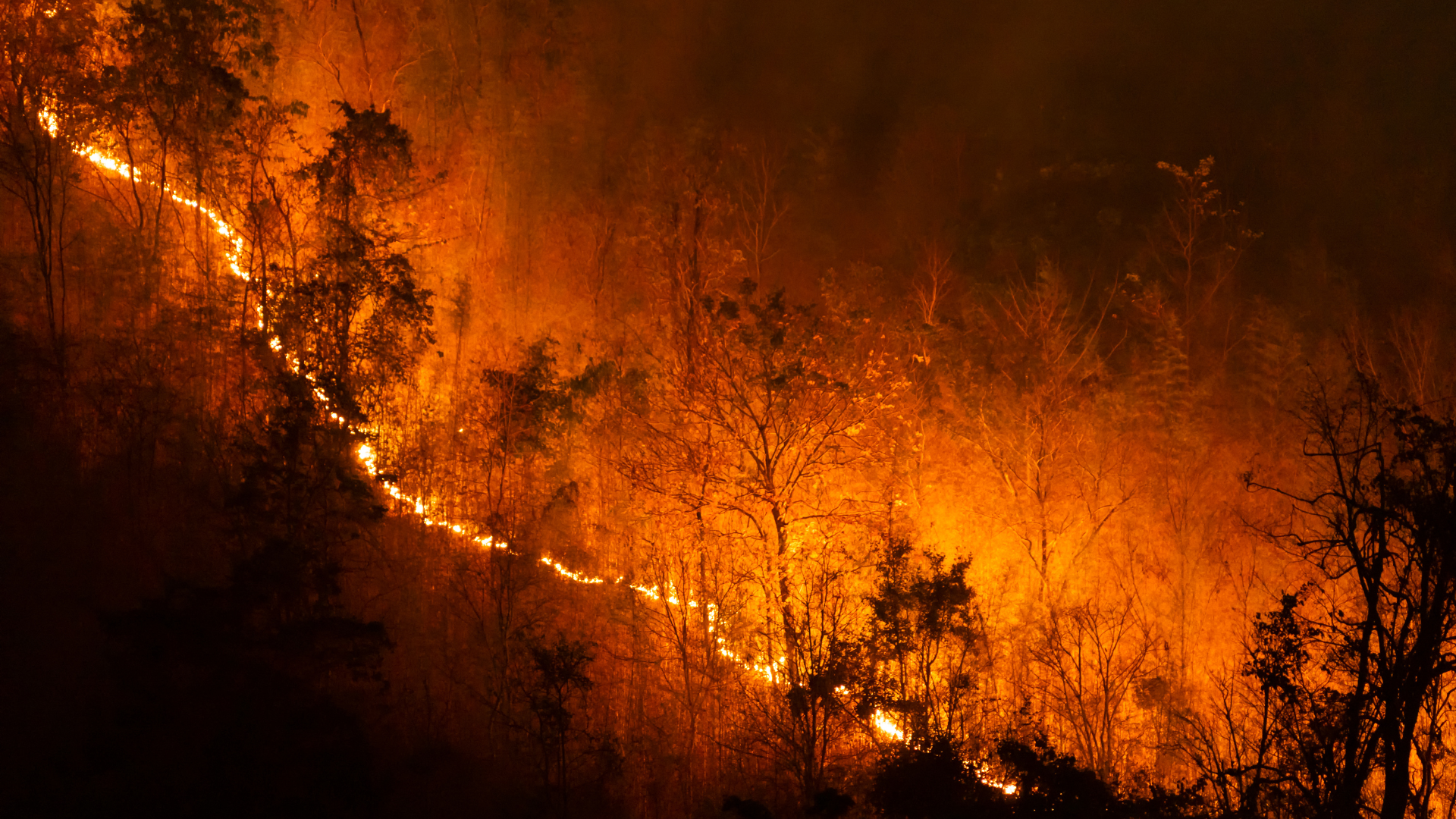NEWS

IN BRIEF

This article delves into Pakistan's escalating wildfire crisis, highlighting the urgent need for a multifaceted and resilient response. Through historical analysis, examination of societal impacts, and scrutiny of government actions, we propose a comprehensive strategy for mitigating wildfire damage and fostering community resilience.
SHARE
Introduction
Pakistan stands at the crossroads of an environmental crisis, besieged by wildfires exacerbated by climate change and anthropogenic factors. These conflagrations not only decimate vast swathes of forested land but also instill profound anxiety regarding the future of our natural environment and societal well-being. This paper aims to present a thorough analysis of the wildfire phenomenon in Pakistan, emphasizing the necessity of a holistic response encompassing prevention, mitigation, and community support.
Deforestation poses a severe threat to Pakistan, a country where only 4.5% of the land is covered by forests (Hayat et al., 2019; Rafaqat et al., 2022). This alarming statistic highlights the critical need to address the factors contributing to forest degradation. Among these factors are a burgeoning population, widespread dependence on firewood, frequent forest fires, and commercial exploitation, compounded by improper grazing management, illegal harvesting, and smuggling activities (Nafees and Asghar, 2009; Khurshid et al., 2022). The negative repercussions of deforestation are particularly acute for rural communities reliant on forest resources, with firewood meeting approximately fifty percent of rural fuel demands (Khan and Khan, 2009; Hussain et al., 2022).
The inadequacy of forest production to meet the increasing domestic and industrial demand for timber, fuel wood, and livestock fodder is further exacerbated by the growing threat of wildfires (Haq et al., 2022). Pakistan’s vulnerability to deforestation, intensified by forest fires, is rooted in the larger socio-ecological system that encompasses human activities and environmental factors (Otto et al., 2022; Abbasi et al., 2023). Wildfires, particularly prevalent in the Northern Mountains of Khyber Pakhtunkhwa, are fueled by dry climates, extensive grazing, human encroachment, and the presence of highly combustible crops like maize (Ali et al., 2020; Ullah et al., 2022). The Chitral district, with one of the highest forest cover percentages at 10%, exemplifies regions that are highly susceptible to wildfires, where remote and isolated communities face significant vulnerability due to limited preparedness for such disasters (Shehzad et al., 2014).

Historical Context and Causes of Wildfires in Pakistan
In recent decades, Pakistan has faced a series of significant wildfires, each leaving a profound imprint on its diverse landscapes and communities. The Margalla Hills wildfires of 2010 near Islamabad, the 2016 blazes in Azad Jammu and Kashmir, and the 2019 fires in Khyber Pakhtunkhwa’s Swat Valley stand as poignant reminders of the destructive potential of wildfires in the region. More recently, in 2024, wildfires once again ravaged the Margalla Hills, threatening critical biodiversity and highlighting ongoing challenges in wildfire management. The fires of 2020 in Chitral and 2023 in Balochistan’s Hingol National Park further underscore Pakistan’s susceptibility to such disasters. These incidents underscore the critical need for robust and adaptive wildfire management strategies tailored to Pakistan’s varied geographical and ecological landscapes, emphasizing proactive prevention, advanced detection technologies, and community resilience to mitigate future wildfire risks effectively.
The climate in various regions of Pakistan, including areas like the Malakand Division, exhibits a warm and temperate profile, with mean annual temperatures around 19.9 °C (Bacha et al., 2018; Khan et al., 2020). During the summer, temperatures can reach highs of 31 °C, with monthly temperatures ranging from 14.81 °C to 31.48 °C in the peak summer months (Nafees, 2008; Bacha et al., 2018). The southwest monsoon brings summer rains, which typically prevent spontaneous fire ignition at these temperatures. Winter temperatures vary significantly, with ranges from 8.7 °C to 23.7 °C in October and from 2.6 °C to 17.1 °C in December, influenced by the Mediterranean’s “Western Disturbance” (Nafees, 2008).
Despite these climatic conditions, the frequency of forest fires in Pakistan has surged in recent years, driven primarily by dry conditions and strong winds that facilitate the rapid spread of fires once ignited (Dendy et al., 2022; Halba et al., 2022). Although the summer temperatures themselves are not typically high enough to spontaneously ignite fires, the intense heat can exacerbate the spread of fires that have started due to other factors (Shu et al., 2022). Rising global temperatures due to climate change have further contributed to the increasing frequency of forest fires (Lestienne et al., 2022; Tariq et al., 2022).
Compounding the issue is improper forest management and the actions of local populations. Forest authorities report that fires are often started either intentionally or unintentionally by locals, leading to uncontrolled wildfires with devastating impacts on ecosystems (Nafees and Asghar, 2009). Similar to global patterns, human-induced fires in Pakistan result in more intense fire behavior, causing significant ecological damage (Nafees et al., 2009). This complex interplay of climatic conditions, human activities, and inadequate management underscores the urgent need for comprehensive strategies to address the wildfire crisis in Pakistan.
A retrospective examination reveals a disconcerting increase in wildfire incidents across Pakistan. From the verdant forests of Murree to the rugged terrains of Khyber Pakhtunkhwa, every region has felt the devastating impact of these fires. The frequency and intensity of these wildfires serve as poignant reminders of the pressing need for strategic interventions to mitigate their effects and preserve our natural heritage.
Societal Impacts
Wildfires in Pakistan have had profound impacts across nature, people, and the economy. Ecologically, these fires devastate natural habitats and biodiversity. For instance, the 2019 wildfires in Khyber Pakhtunkhwa’s Swat Valley destroyed over 50,000 acres of forest, impacting wildlife habitats and endangering species such as the Himalayan brown bear and Markhor goat (WWF Pakistan, 2019). Economically, wildfires incur substantial costs in terms of firefighting efforts, property damage, and lost agricultural productivity. In 2020, the fires in Chitral caused estimated losses exceeding PKR 100 million (USD 600,000), including damage to infrastructure and loss of livestock (Dawn News, 2020).
On a human level, wildfires pose immediate risks to health and safety due to smoke inhalation and evacuations. During the 2024 Margalla Hills fires, air quality deteriorated significantly in Islamabad, exacerbating respiratory issues among residents (The News International, 2024). Beyond immediate impacts, prolonged exposure to wildfire smoke is associated with increased hospital admissions for respiratory and cardiovascular illnesses (Springer et al., 2022).
Exploring the causes of these wildfires reveals a complex interplay of natural and human factors. Natural causes include dry weather conditions and lightning strikes, which ignite dry vegetation during drought periods. Human activities, such as agricultural burning, industrial activities, and unauthorized land clearing, also contribute significantly. Moreover, illegal logging and encroachments into forested areas exacerbate fire risks, driven by socio-economic pressures and insufficient enforcement of environmental regulations (Nafees & Asghar, 2009). Addressing these multifaceted causes requires integrated strategies that combine effective land management practices, community engagement, and policy interventions to reduce wildfire risks and promote sustainable environmental stewardship in Pakistan.
The repercussions of wildfires extend beyond ecological destruction, profoundly affecting societal structures. Communities plagued by frequent wildfires experience heightened levels of anxiety, stress, and a pervasive sense of helplessness. The psychological burden necessitates targeted mental health interventions, including the establishment of support networks and the provision of counseling services.
Individual actions, though seemingly modest, can cumulatively effect significant change. Fire safety education, participation in conservation efforts, and advocacy for stringent environmental policies are pivotal in creating a wildfire-resilient future. Collective community efforts can amplify these individual actions, fostering a culture of preparedness and environmental stewardship.
Strategic Response Framework
Mitigating and preventing forest fires in Pakistan requires a multi-faceted approach involving both government initiatives and individual actions. By addressing the root causes and enhancing response capabilities, we can reduce the frequency and impact of these destructive events.
Policy level Interventions:
- Improved Forest Management:
The government must invest in sustainable forest management practices. This includes regular thinning of forests to remove excess vegetation that can fuel fires, and the creation of firebreaks—gaps in vegetation that slow the spread of fires (Nafees et al., 2009).
- Early Detection and Monitoring:
Implementing advanced technologies such as satellite imagery and remote sensing for early detection of wildfires can significantly enhance response times. The use of drones for real-time monitoring can help in quickly identifying and addressing fire outbreaks (Shu et al., 2022).
- Community Education and Training:
The government should launch comprehensive education campaigns to raise awareness about the causes and prevention of forest fires. Training programs for local communities on fire management techniques, such as controlled burns and safe fire usage, can empower them to act effectively during emergencies (Lestienne et al., 2022).
- Strengthening Legislation and Enforcement:
Strengthening laws against illegal logging and the activities of the “Timber mafia” is crucial. Strict enforcement and higher penalties for those who deliberately start fires can deter such actions and reduce the incidence of man-made fires (Nafees and Asghar, 2009).
- International Collaboration:
Collaborating with international organizations to exchange knowledge and resources can enhance Pakistan’s capacity to manage and prevent forest fires. Participation in global initiatives and adopting best practices from countries with advanced wildfire management systems can provide valuable insights (Dendy et al., 2022).
Community Based Actions:
- Responsible Fire Use:
Individuals must exercise caution when using fire in or near forested areas. This includes adhering to local regulations regarding campfires, burning debris, and other activities that could ignite fires. Properly extinguishing campfires and disposing of cigarettes safely are simple yet effective measures (Khan et al., 2020).
- Reporting Fires Promptly:
Promptly reporting any signs of fire to authorities can prevent small fires from becoming uncontrollable. Individuals should be aware of emergency contact numbers and procedures for reporting wildfires (Bacha et al., 2018).
- Participating in Community Initiatives:
Engaging in community efforts such as reforestation projects and fire prevention workshops can strengthen local resilience against wildfires. Volunteering for local fire brigades or supporting conservation organizations can also make a significant impact (Halba et al., 2022).
- Reducing Fuel Sources Near Homes:
Homeowners in fire-prone areas should create defensible space by clearing flammable vegetation around their properties. Planting fire-resistant plants and maintaining green, watered landscapes can reduce the risk of fire spreading to homes (Ullah et al., 2022).
Governmental Accountability and Public Trust
A recurring theme in public discourse is the perceived inadequacy of governmental response to wildfire management. Allegations of fires being deliberately set for illicit gains by entities such as the “Timber mafia” underscore the need for rigorous investigation and accountability. Transparent communication and engagement with affected communities are crucial for rebuilding public trust and ensuring effective wildfire management.
Conclusion
In conclusion, addressing Pakistan’s escalating wildfire threat requires a combined approach of policy-level initiatives and community-based actions. Enhanced forest management through regular thinning and firebreak creation, along with advanced early detection systems like satellite imagery and drones, are crucial. Strengthening laws against illegal logging and promoting international collaborations will also aid in reducing wildfire incidents. Community education on safe fire practices, prompt reporting systems, and involvement in reforestation projects will bolster local resilience. By integrating these strategies and targeting measurable goals such as reducing combustible vegetation and illegal deforestation by significant percentages, Pakistan can safeguard its natural resources and public health while mitigating wildfire risks.
About the Author:
Momina Zahid is a communication officer as at Accountability Lab Pakistan and can be reached out at momina@accountabilitylab.org
